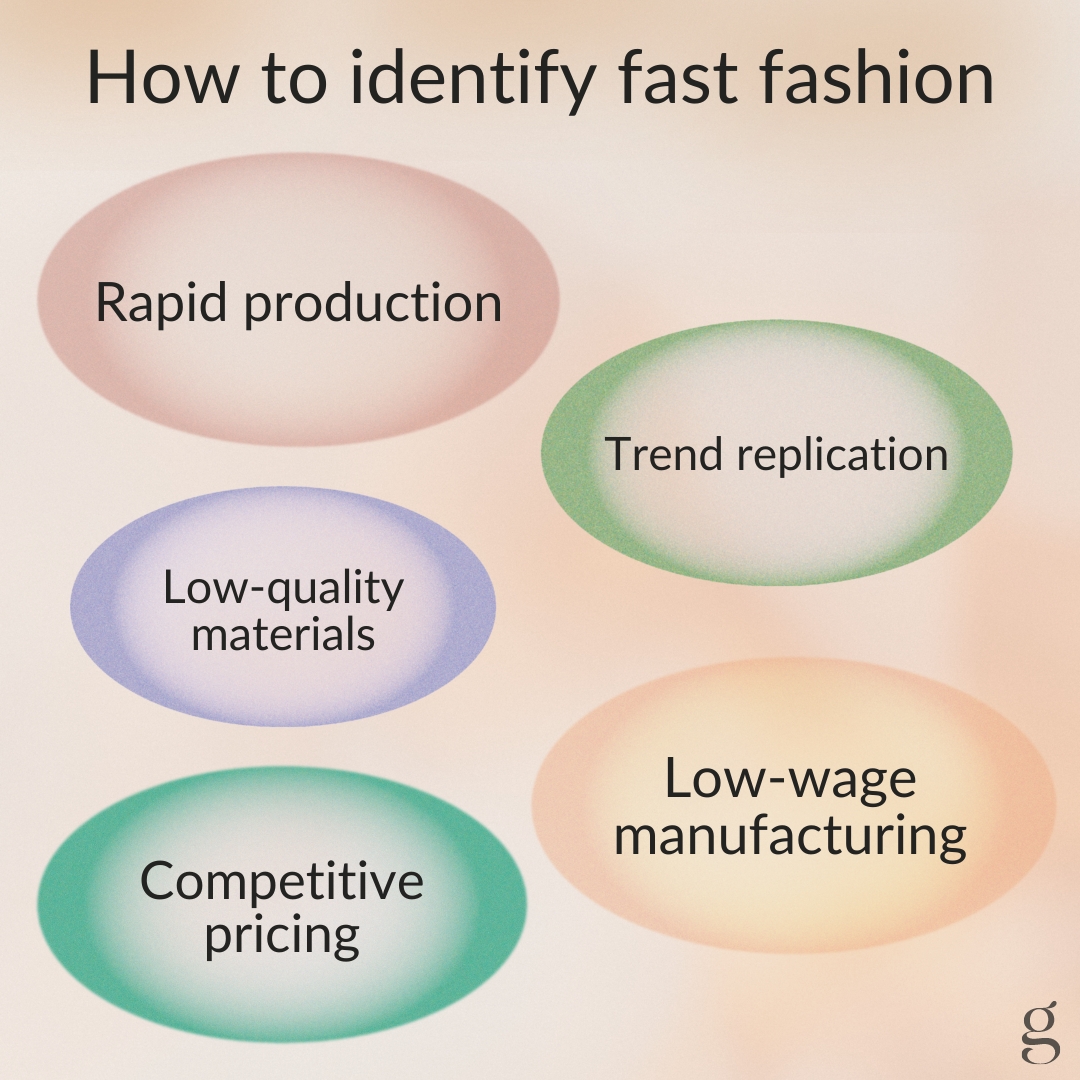What Is Fast Fashion, Anyway?
“Fast fashion” is a buzz phrase but what does this term really mean? And as we continue to encourage the fashion industry to move towards a more sustainable and ethical future, it’s helpful to know what we’re up against.
Fast fashion is a design, manufacturing, and marketing method focused on rapidly producing high volumes of clothing. Fast fashion garment production leverages trend replication and low-quality materials (like synthetic fabrics) in order to bring inexpensive styles to the end consumer.
“Fast fashion is a design, manufacturing, and marketing method focused on rapidly producing high volumes of clothing.”
These cheaply made, trendy pieces have resulted in an industry-wide movement towards overwhelming amounts of consumption. This results in harmful impacts on the environment, garment workers, animals, and, ultimately, consumers’ wallets.
Read below to better understand the fast fashion movement’s history, context, and impact.
A Brief History of The Fashion Industry
Up until the mid-twentieth century, the fashion industry ran on four seasons a year: fall, winter, spring, and summer. Designers would work many months ahead to plan for each season and predict the styles they believed customers would want. This method, although more methodical than fashion today, took away agency from the wearers. Before fashion became accessible to the masses, it was prescribed to high society, and there were rules to be followed.
It wasn’t until the 1960s that a well-timed marketing campaign for paper clothes proved consumers were ready for the fast fashion trend. This resulted in the fashion industry quickening its pace and lowering costs.
“Nowadays, fast fashion brands produce about 52 “micro-seasons” a year—or one new “collection” a week leading to massive amounts of consumption and waste.”
However, it wasn’t until a few decades later, when fast fashion reached a point of no return. According to the Sunday Style Times, “It particularly came to the fore during the vogue for ‘boho chic’ in the mid-2000s.”
Nowadays, fast fashion brands produce about 52 “micro-seasons” a year—or one new “collection” a week. According to author Elizabeth Cline, this started when Zara shifted to bi-weekly deliveries of new merchandise in the early aughts. Since then, it’s been customary for stores to have a towering supply of stock at all times, so brands don’t have to worry about running out of clothes. By replicating streetwear and fashion week trends as they appear in real-time, these companies can create new, desirable styles weekly, if not daily. The brands then have massive amounts of clothing and can ensure that customers never tire of inventory.
While brands like H&M, Topshop, and Zara have been the brunt of overproduction complaints, even luxury brands measure growth by increasing production. According to Fast Company, “apparel companies make 53 million tons of clothes into the world annually,” and the amount has surely increased since the article’s original release in 2019. “If the industry keeps up its exponential pace of growth, it is expected to reach 160 million tons by 2050.”
Is Fast Fashion Bad?
Many people debate what came first: the desire for fresh looks at an alarming rate or the industry’s top players convincing us that we’re behind trends as soon as we see them being worn. It’s hard to say, but there is no doubt that we thirst for the “next best thing” every day of our consumer-driven lives. (“10 Things I Hate About You,” anyone?)
Yet, with this increased rate of production and questionable supply chains, corners are inevitably cut. Clothing is made in a rushed manner, and brands are selling severely low-quality merchandise. There isn’t enough time for quality control or to make sure a shirt has the right amount of buttons—not when there is extreme urgency to get clothing to the masses.
The fast-fashion manufacturing process leaves a lot to be desired, and pieces are often thrown away after no more than a few wears. The same urgency that throws quality out the window also keeps the costs of these garments incredibly low. Companies like Topshop and Fashion Nova are greatly concerned with their bottom line and are banking on the “ocean of clothing” they churn out for profit.
These brands earn millions of dollars while selling pieces cheaply because of the sheer number of items they sell, no matter the cost or markup. And garment workers are undoubtedly being paid well below the minimum wage. In the documentary “The True Cost,” author and journalist Lucy Siegle summed it up perfectly: ”Fast fashion isn’t free. Someone, somewhere is paying.”
“Fast fashion isn’t free. Someone, somewhere is paying.”
— LUCY SIEGLE
Moral lines get blurred, however, when factoring in how much more accessible and size-inclusive fast fashion can be. Ethical fashion advocates have worked hard to unpack this complicated narrative, but the cost and exclusive-sizing are still barriers for many.
The Human & Environmental Impact of Fast Fashion
All of the elements of fast fashion—trend replication, rapid production, low quality, competitive pricing—have a detrimental impact on the planet and the people involved in garment production.
Brands like Boohoo, for example, use toxic chemicals, dangerous dyes, and synthetic fabrics that seep into water supplies, and, each year, 11 million tons of clothing is thrown out in the US alone. These garments—full of lead, pesticides, and countless other chemicals—rarely break down. Instead, they sit in landfills, releasing toxins into the air. Fast fashion’s carbon footprint gives industries like air travel and oil a run for their money.
“Many of us are familiar with the news about Nike sweatshops, but they’re just one of the many fast fashion brands violating human rights for the sake of fashion.”
In addition to environmental impact, fast fashion affects the health of consumers and garment workers. Harmful chemicals such as benzothiazole—linked to several types of cancer and respiratory illnesses—have been found in apparel on the market today. As our skin is the largest organ of the body, wearing these poorly made clothes can be dangerous to our health.
This danger only increases in factories, towns, and homes where fast fashion is made. For example, according to the Environmental Health Journal, conventional textile dyeing often releases “heavy metals and other toxicants that can adversely impact the health of animals in addition to nearby residents” into local water systems.
The health of garment workers is always in jeopardy through exposure to these chemicals. And that doesn’t even take into account the long hours, unfair wages, lack of resources, and even physical abuse. Many of us are familiar with the news about Nike sweatshops, but they’re just one of the many fast fashion brands violating human rights for the sake of fashion. The people who make our clothes are underpaid, underfed, and pushed to their limits because there are few other options. Instead, we can proactively support garment workers and fight for better conditions and wages.
Qualities of Fast Fashion Brands

Here’s how you can spot fast fashion brands when shopping online or in-store:
-
Look for rapid production, are new styles launching every week?
-
Look for trend replication, are styles from a particular brand cheaply made versions of trends from recent fashion shows?
-
Look for low-quality materials, are fabrics synthetic and garments poorly constructed, made only to last a few wears?
-
Look where manufacturing is taking place, is production happening where workers receive below living wages?
-
Look for competitive pricing, is new stock released every few days and then discounted steeply when it doesn’t sell?
The Rise of Slow Fashion
“It’s encouraging to know that there are brands, communities, and individuals out there fighting for the planet and the safety of garment workers.”
Although the fashion industry as a whole is guilty of committing many crimes against people and the environment, it is most evident when it comes to fast fashion. Society’s obsession with consumerism may make it hard to quit, but better options are out there.
Slow fashion offers an alternative, with mindful manufacturing (sometimes including vertically integrated and in-house production), fair labor rights, natural materials, and lasting garments. It’s encouraging to know that there are brands, communities, and individuals out there fighting for the planet and the safety of garment workers.
By buying garments from responsible brands, speaking up for social responsibility and accountability, and going through secondhand shops, we can ensure agency and that we’re advocating for the environment and others.



